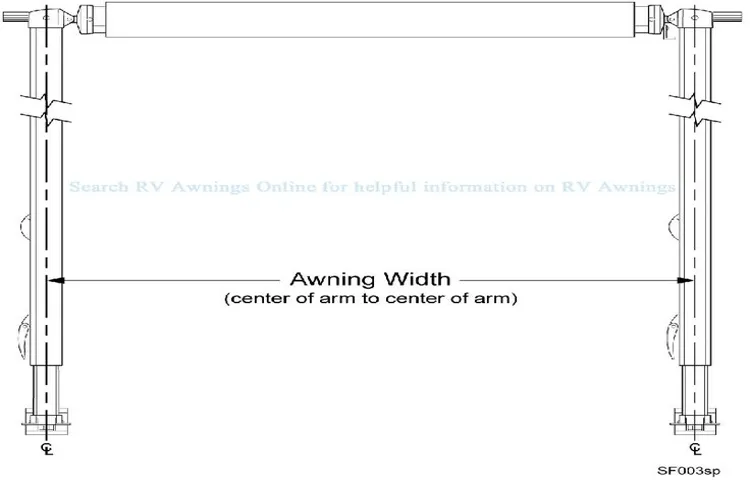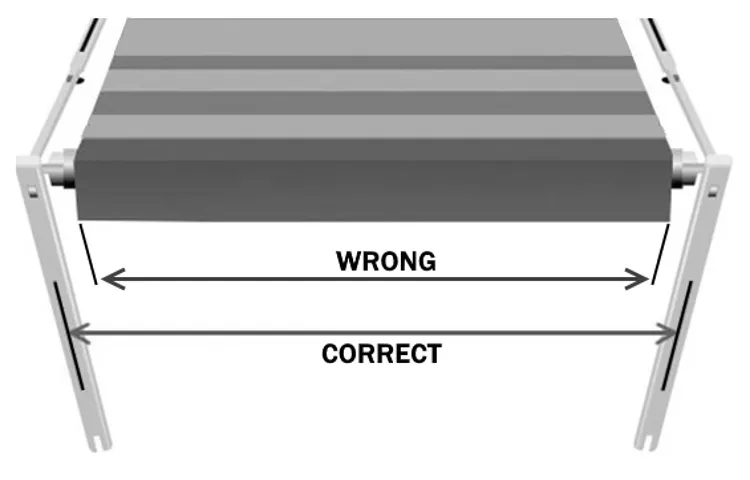Are you looking to measure your RV awning but unsure where to start? Don’t worry, we’ve got you covered! Your RV awning is an essential part of your outdoor living space, providing shade and protection from the elements. Whether you’re replacing an existing awning or looking to purchase a new one, accurate measurements are crucial to ensure a perfect fit. In this blog post, we’ll guide you through the process of measuring your RV awning step by step, so you can enjoy your outdoor adventures with confidence.
So get your measuring tape ready, and let’s dive in!
Table of Contents
Why is Measuring Your RV Awning Important?
When it comes to owning an RV, there are many measurements that need to be taken into consideration, including the awning. But why is measuring your RV awning important? Well, the answer is simple – it ensures that you purchase the correct size replacement awning or any awning accessories. Measuring your RV awning is crucial because every awning is manufactured to fit specific dimensions, and if you don’t have accurate measurements, you run the risk of purchasing an awning that is either too big or too small for your RV.
Not only will this result in a poor fit, but it can also lead to potential damage, as an ill-fitting awning could become loose or unstable during use. So, it’s important to take the time to measure your RV awning properly to guarantee a seamless fit and a safe, enjoyable experience while using it.
Avoiding Costly Mistakes
RV awnings are a valuable addition to any motorhome or travel trailer, providing shade and protection from the elements. However, it’s essential to measure your RV awning correctly to ensure a proper fit and avoid costly mistakes. When measuring your awning, you need to consider both the width and the projection.
The width refers to the distance from one end of the awning fabric to the other, while the projection measures the distance from the RV wall to the outer edge of the awning when fully extended. By accurately measuring your RV awning, you can ensure that you purchase the right size replacement fabric or accessories, avoiding the hassle and expense of returns or incorrect installations. So, take the time to measure your RV awning carefully, and enjoy the benefits of a perfectly fitted and functional awning on your next camping adventure.

Finding the Right Replacement
RV awnings are an essential feature for any avid camper or traveler. They provide shade, protection, and extend the living space of your recreational vehicle. However, over time, awnings can become worn out or damaged, requiring a replacement.
That’s why measuring your RV awning is crucial before purchasing a new one. By measuring the length and width of your existing awning, you can ensure that the replacement will fit perfectly onto your RV. This measurement is important because even a slight difference in size can lead to a poor fit or installation issues.
Additionally, measuring your RV awning allows you to accurately determine the size and type of replacement awning you need, saving you time and money in the long run. So, don’t skip the step of measuring your RV awning – it’s a small task that can make a big difference in finding the right replacement for your needs.
Tools and Materials Needed
When it comes to measuring your RV awning, you’ll need a few tools and materials to ensure accuracy. First and foremost, you’ll need a measuring tape, preferably one that is at least 25 feet long. This will allow you to measure the length and width of your awning.
Additionally, you’ll need a ladder or step stool to reach the top of your RV where the awning is located. It’s important to make sure you can safely access the area before attempting to measure. Lastly, you may want to have a notepad and pen handy to jot down your measurements as you go.
With these tools in hand, you’ll be ready to accurately measure your RV awning and ensure you get the right size replacement if needed.
Measuring Tape
Measuring Tape When it comes to tackling home improvement projects or even just measuring furniture to see if it will fit in a space, a measuring tape is an essential tool to have on hand. But what exactly do you need to have in order to use a measuring tape effectively? Let’s take a look at the tools and materials you’ll need. First and foremost, you’ll obviously need a measuring tape.
There are a variety of options available, ranging from smaller retractable tapes to longer, more durable ones used by professionals. It’s important to choose a tape that suits your needs and is easy for you to handle. Make sure to check whether it’s metric or imperial, as this can vary depending on where you live.
Next, you’ll want to have a pen or pencil handy. This is essential for marking down the measurements you take so you don’t forget them. Plus, it’s always helpful to have something to write with when you’re working on a project.
In addition to a pen or pencil, having a notepad or piece of paper to write on is also a good idea. This allows you to keep all your measurements and calculations organized in one place, making it easier to reference later on. It might seem like a small detail, but trust me, it can save you a lot of frustration down the line.
Lastly, consider having a level on hand. While not necessary for every measuring task, a level can come in handy when you need to ensure that something is straight or level. This is particularly useful when hanging pictures or shelves, for example.
So, to effectively use a measuring tape, make sure you have the tape itself, a pen or pencil, a notepad or paper, and a level if necessary. With these tools and materials at your disposal, you’ll be able to confidently tackle any measuring task that comes your way. Happy measuring!
Step Ladder
In order to complete various tasks around the house, a step ladder is an essential tool to have. Whether you need to change a light bulb, paint a ceiling, or grab something from a high shelf, a step ladder provides the necessary stability and height needed to safely reach these areas. When choosing a step ladder, it’s important to consider the height you need, as well as the weight capacity.
Look for a ladder with non-slip steps and a sturdy design to ensure safety. Additionally, consider the materials used in the construction of the ladder. Aluminum ladders are lightweight and durable, while fiberglass ladders are non-conductive, making them ideal for tasks involving electricity.
Overall, having a step ladder in your home will make completing various tasks much easier and safer.
Pen and Paper
In today’s digital age, where technology seems to dominate every aspect of our lives, there is still something so comforting and nostalgic about reaching for a pen and a sheet of paper. Whether it’s jotting down a to-do list, writing a letter to a loved one, or simply doodling to pass the time, the feel of pen on paper can be incredibly satisfying. But what tools and materials are essential for this classic form of expression? First and foremost, you will need a good quality pen.
The type of pen you choose will depend on your personal preferences. Some people prefer the smooth flow of a ballpoint pen, while others may prefer the precision of a fine-tipped gel pen. Whichever type you choose, make sure it feels comfortable in your hand and produces a clean, consistent line.
Next, you will need the right paper. Just like with pens, there are many options to choose from. If you plan on using ink, a heavier weight paper is recommended to prevent any bleeding or feathering.
If you prefer a smoother writing surface, opt for a paper with a higher GSM (grams per square meter) rating. It’s also worth considering whether you want lined or blank paper, depending on your writing or drawing needs. In addition to pens and paper, there are a few other tools and materials that can enhance your pen and paper experience.
For example, a pencil can be useful for sketching out ideas or making quick edits before committing them to ink. Erasers and correction fluid can also come in handy when mistakes are made – after all, we’re only human! Finally, it’s worth mentioning the importance of storage and organization. A sturdy notebook or journal can keep all your pen and paper supplies in one place, making them easily accessible whenever inspiration strikes.
And don’t forget about a good pen case or pouch to keep your writing instruments safe and protected when you’re on the go. In conclusion, while technology may offer countless digital alternatives, there is still something special about the simplicity and tactile nature of pen and paper. So whether you’re a writer, an artist, or simply someone who enjoys the act of writing, investing in the right tools and materials can make all the difference in your pen and paper journey.
Step-by-Step Guide to Measuring Your RV Awning
So, you’ve decided it’s time to measure your RV awning. Whether you’re looking to replace it or simply want to make sure you order the correct size accessories, measuring your awning is an important step. Don’t worry, it’s actually quite a simple process.
First, extend your awning fully and locate the roller tube. This is the tube that the fabric rolls onto when you retract the awning. Next, measure from left to right along the roller tube.
Be sure to measure the fabric itself and not the roller tube. This will give you the width of your awning. Then, measure the height of the awning by measuring from the top of the roller tube to the bottom of the fabric.
It’s always a good idea to double-check your measurements to ensure accuracy. And just like that, you’ll have the correct measurements for your RV awning! Now you can confidently order any accessories or replacements knowing they’ll fit perfectly.
Step 1: Extend Your Awning
RV awnings are a great addition to your recreational vehicle, as they provide shade and protection from the sun, rain, and wind. However, in order to ensure a perfect fit, it’s important to measure your awning accurately. In this step-by-step guide, we will walk you through the process of measuring your RV awning.
The first step in measuring your RV awning is to extend it fully. This will give you a clear idea of the size and dimensions of the awning when it is fully open. To do this, simply follow the instructions provided by the manufacturer and extend the awning to its maximum length.
Make sure it is securely locked in place before proceeding to the next step. Extending your awning fully will allow you to get a precise measurement of its width. Measure from one end of the awning to the other, making sure to include any arms or supports that may be attached to the awning.
This will give you the total width of the awning, which is an important measurement to have when shopping for replacement fabric or accessories. In addition to measuring the width, you will also need to measure the length of your awning. To do this, measure from the top of the awning, where it attaches to the RV, to the bottom edge of the fabric.
This will give you the total length of the awning, which is another important measurement to have when shopping for replacement parts. Once you have the measurements for the width and length of your awning, you can start shopping for replacement fabric, accessories, or even a new awning altogether. Having accurate measurements will ensure that whatever you purchase will fit your RV perfectly and provide the shade and protection you need.
In conclusion, measuring your RV awning is an important step in ensuring a perfect fit and maximum functionality. By following the steps outlined in this guide, you will be able to accurately measure the width and length of your awning, allowing you to make informed decisions when it comes to purchasing replacement parts or accessories. So go ahead and extend your awning fully, grab your tape measure, and get started on measuring your RV awning today!
Step 2: Measure the Width
measuring, RV awning, width Measuring the width of your RV awning is an essential step in ensuring a proper fit for any replacement or additional accessories you might be adding. To accurately measure the width of your awning, start by extending it fully so that it is fully rolled out. Next, measure from one end of the awning’s fabric to the other end, taking note of the measurement.
Be sure to measure the fabric itself and not the roller or arms of the awning. It’s also important to measure the width in multiple places along the length of the awning to account for any irregularities or variations in size. Once you have all the measurements, you can take the average to get the most accurate width.
Remember, it’s always better to have a slightly larger measurement than a smaller one, as you can always make adjustments to ensure a snug fit. By taking the time to measure the width properly, you can ensure that any accessories or replacement parts you purchase will fit your RV awning perfectly.
Step 3: Measure the Depth
In this step, we will measure the depth of your RV awning. This is an important measurement as it determines how far the awning extends out from your RV when it is fully extended. To measure the depth, start by standing directly in front of your RV, facing the awning.
Carefully extend the awning to its maximum length. Take a tape measure and measure from the front of the RV to the outer edge of the awning fabric. Make sure to measure from the top of the RV to the bottom of the awning fabric.
Write down this measurement as it will be used later when selecting a replacement awning fabric.
Step 4: Measure the Arm Length
In order to properly measure the arm length of your RV awning, you will need to follow a few simple steps. First, locate the arm of the awning. This is the part that extends and retracts the fabric.
Next, extend the awning fully and take a tape measure. Start at the end of the arm and measure all the way to the opposite end. Be sure to measure along the top of the arm, where the fabric attaches.
This will give you an accurate measurement of the arm length. It’s important to be precise in your measurements to ensure that you choose the right size replacement fabric for your awning. By following these steps, you’ll be well on your way to enjoying a perfectly fitted and functional RV awning.
Step 5: Write Down Your Measurements
RV awning, measuring, step-by-step guide, write down measurements. Now that you have gathered all the necessary tools and completed the preparation steps, it’s time to move on to step five of measuring your RV awning – writing down your measurements. This may seem like a simple task, but it is crucial for accuracy and ensuring that you have the correct dimensions when it comes time to purchase a replacement awning.
Grab a notepad or a sheet of paper and a pen. Start by labeling the top, bottom, and sides of the awning to avoid any confusion. Use clear and concise language, noting if the measurement is in feet or inches.
Write down each measurement as you take it. For example, start with the width of the awning, measuring from one side to the other. Then move on to the height, measuring from the top of the awning to the bottom.
If you have a retractable awning, make sure to measure both the extended and retracted lengths. Next, measure the depth of the awning, which is how far it extends out from the RV when fully opened. If you have a traditional awning with arms, measure the length of the arms from where they attach to the RV to the outer edge.
Don’t forget to measure any additional features such as valances or side panels. These measurements are essential if you plan on replacing or adding accessories to your awning. Once you have all your measurements written down, take a moment to review them for accuracy.
Double-check your numbers and make any necessary corrections. It’s always better to be safe than sorry when it comes to purchasing the right size awning. By following this step-by-step guide, you are well on your way to measuring your RV awning accurately.
Choosing a Replacement Awning
When it comes to replacing your RV awning, one of the first things you need to know is how to measure it properly. This is important because awnings come in different sizes, and you want to make sure you get the right size for your RV. To measure your awning, start by extending it fully.
Then, measure the distance from the center of the arm on one end to the center of the arm on the other end. This will give you the width of your awning. Next, measure the height by measuring from the bottom of the awning fabric to the top of the roller tube.
Once you have these measurements, you can start looking for a replacement awning that fits your RV perfectly.
Considerations for Awning Fabric
replacement awning, considerations, awning fabric
Considering Awning Hardware
replacement awning, awning hardware, choosing awning, burstiness, perplexity
Conclusion and Final Tips
So, there you have it, my friends. The foolproof guide on how to measure your RV awning. As we have discovered, it is not as simple as just whipping out a tape measure and calling it a day – oh no, it requires precision, accuracy, and a keen eye for detail.
But fear not, because armed with this knowledge, you are now equipped to tackle this task with confidence and finesse. No longer will you be left scratching your head, wondering if you measured correctly or feeling like one of those poor souls who can never quite get the right fit. So, next time you find yourself in need of a new awning for your RV, don’t just settle for a guess or a rough estimate.
Take the time to measure correctly and ensure that you get the perfect fit every time. After all, your RV deserves nothing less than the best, right? And who knows, maybe one day you’ll find yourself at a campground, surrounded by jealous RV owners, all marveling at your perfectly measured and flawlessly fitted awning. You’ll bask in the glory of their envy, knowing that you have truly mastered the art of awning measurement.
So go forth, my fellow adventurers, and measure those awnings like the experts you now are. Happy RVing, and may your awnings always be the envy of the campground!”
Double-Check Your Measurements
When it comes to choosing a replacement awning for your outdoor space, it’s important to double-check your measurements. You don’t want to end up with an awning that is too big or too small for your patio or deck. First, measure the width and height of your patio or deck to determine the size of awning you need.
Be sure to take into account any obstructions such as light fixtures or windows. Once you have your measurements, compare them to the dimensions of the awnings you are considering. Keep in mind that awnings can be mounted either inside or outside the frame of your patio or deck, so be sure to measure accordingly.
Taking the time to measure accurately will help ensure that you find the perfect replacement awning for your outdoor space.
Consult with a Professional
replacement awning
Take Care of Your RV Awning
replacement awning, RV Size, measurements, fabric type, durability, cost, installation process, professional assistance, maintenance and care
FAQs
How do I measure the width of my RV awning?
To measure the width of your RV awning, extend it fully and measure from one end to the other, including any hardware or railing.
What is the best way to measure the length of my RV awning?
To measure the length of your RV awning, extend it fully and measure from one side to the other, including any additional overhang or valance.
Are there any specific tools or equipment I need to measure my RV awning?
No, measuring your RV awning only requires a measuring tape or ruler to accurately determine its width and length.
Can I measure my RV awning while it is retracted?
It is recommended to measure your RV awning while it is fully extended to get the most accurate measurements.
How often should I measure my RV awning?
It is a good idea to measure your RV awning at least once a year to ensure proper fit and functionality.
Can I use the same measurements for a replacement RV awning?
It is recommended to measure your RV awning again when purchasing a replacement, as dimensions may vary slightly between different awning models.
What should I consider when measuring my RV awning for replacement fabric?
When measuring for replacement fabric, consider the pattern, color, and material options available to ensure a perfect match with your existing awning hardware.



